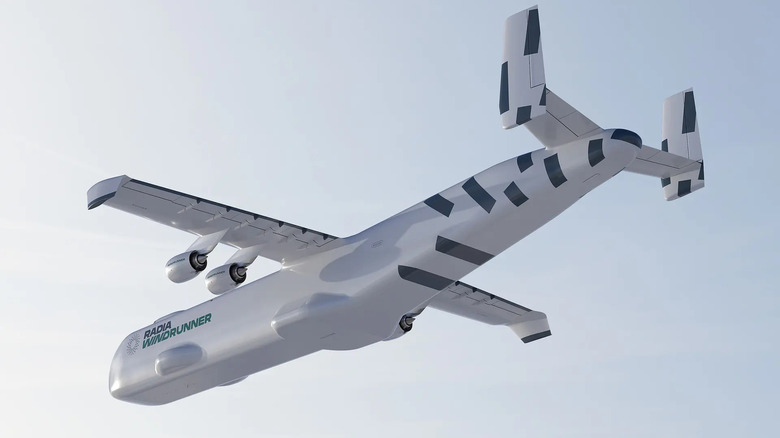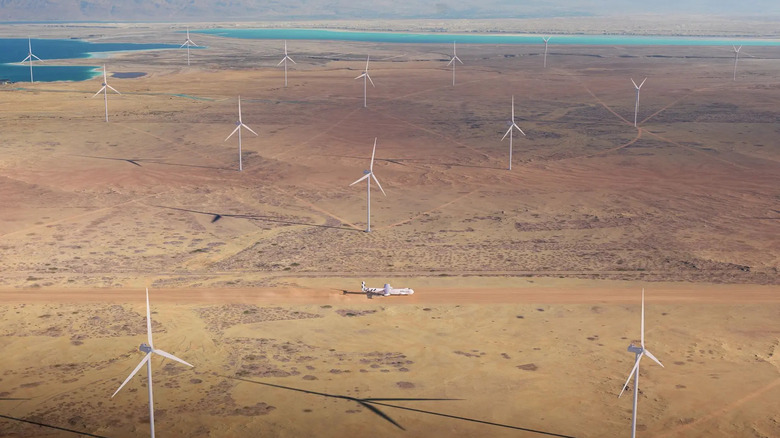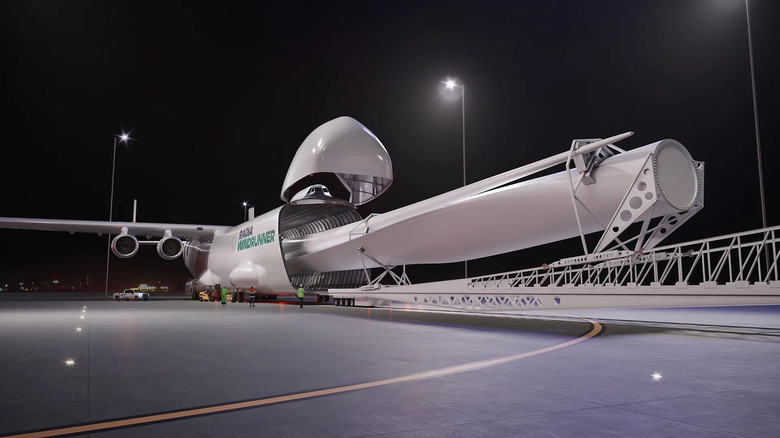This Colossal Concept Jet Could Revolutionize Clean Energy
If you've ever seen wind turbines being transported down the highway, you know these are massive objects. Stretching hundreds of feet long, these clean energy prospects can be challenging to maneuver on land. That's where the Radia Windrunner comes in.
With a name like something out of a "Legend of Zelda" game, the Windrunner is designed to transport wind turbines in the sky, where there aren't as many spacial limitations. Stretching 354 feet long with a 261-foot wingspan, the Radia Windrunner would dwarf the biggest plan ever built, the Antonov An-225 Mriya, if constructed. To put the size of this revolutionary plane into perspective, think about the size of an American football field, which measures 360 feet long from endzone to endzone. Plus, its wingspan is 101 feet wider than a football field's width, too.
How will this behemoth work? The goal is to load turbine blades into the Windrunner through its nose, which lifts up much like the massive C-5M Super Galaxy. There, the blades will sit in the plane's 272,000 cubic-feet cargo bay until it reaches its destination, which can be anywhere within the Windrunner's 1,200-mile maximum range.
The Radia Windrunner doesn't need a real runway to land
You might be wondering how the Windrunner is going to get the turbine blades to their destination once it lands. Won't Radia also need to use trucks to carry the turbines from the plane to their final destination, running into the same problems the industry faced initially? Not exactly.
The Windrunner will be able land on any straightaway that's at least about 6,000 feet long and without obstacles. This is an impressive feat when one considers that the average large cargo plane needs around 7,000 feet to land safely. Plus, the Windrunner can land on makeshift runways that aren't paved, similar to how some military planes that are notoriously difficult to fly have to land in a pinch.
The idea is that the Windrunner will be able to pull up directly to the land where the turbines will be placed, or near an access road that can easily deliver them. If there's a wind farm that doesn't have a roadway that can be used as a runway for the gargantuan plane, then it wouldn't be difficult to build one before the scheduled delivery. Altogether, Radia says it has run the numbers and came to the conclusion that its airplane project will cut the cost of clean energy by 35%.
The Windrunner could be Radia's first of many ventures into clean energy
Mark Lundstrom, an aerospace engineer who graduated from MIT, founded Radia in 2016 as a means to solve the issue of transporting onshore wind power. He worked in secret for multiple years, garnering support and capital from investors until March 2024 when the company publicly announced its goals. Radia describes itself as a clean energy company first, which happens to be setting itself apart by solving a logistics problem. Radia plans to use the Windrunner for its own wind farms initially but eventually deliver turbines to other projects as well.
The Windrunner is only a small piece of Radia's grander business plan. Lundstrom has aspirations of working alongside other green energy ventures, creating a whole ecosystem of clean energy powering clean energy production. What would that look like? In an interview with Time, Lundstrom said for starters, the plane would use low-cost hydrogen fuel and made it known that he wants Radia to build its turbines on or near a facility producing green hydrogen. Before any of that comes to fruition, however, Radia needs to focus on getting its Windrunner project off the ground.
Radia says the Windrunner will be complete in 2028
As impressive as all of this sounds, the Windrunner is still in its conceptual phase. All of the images included in this story are detailed renderings of the aircraft and its capabilities. So far, Radia has raised $104 million for the project, which is impressive considering Radia worked behind closed doors for seven years before announcing it publicly. However, Radia hasn't stated how large the budget needs to be to build each Windrunner, let alone the entire fleet it's aiming to have at its disposal.
The start-up is hopeful that it will have the first plane built, tested, and certified by 2028, but the plane will still need to go through a series of tests and safety checks once the design is complete. Radia isn't using anything new or cutting edge for Windrunner's design, though, which may speed things along. Lundstrom told Time that he directed his engineers to "do nothing new." With this philosophy driving the construction process, Radia says it wants to have dozens of these aircraft ready to go by 2030.



